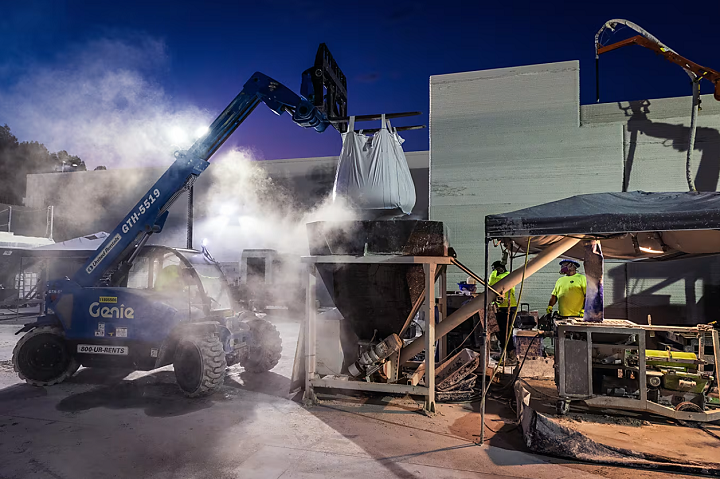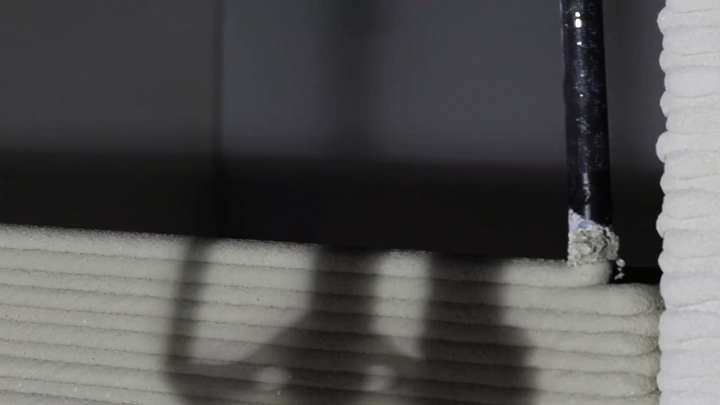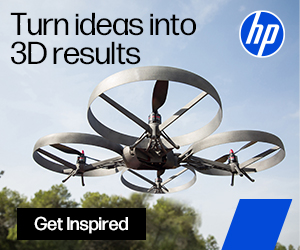Walmart 3D Prints Store Expansion, Marking Commercial Real Estate Milestone
Back in 2017, global enterprise Deloitte published a report about innovations in commercial real estate (CRE), which listed “five themes that CRE owners should consider integral to their business strategy.” One of those themes was 3D printing. Now, it seems that additive construction (AC) could finally be making its mark in the CRE sector. In one of the biggest 3D printed CRE projects in U.S. history, American retail giant Walmart has added an 8,000-square-foot expansion to its Supercenter location in Athens, Tennessee. The company was intrigued by AC technology, which is often showcased as a potential savior for the country’s housing shortage, and wanted to see if it could really be used to build the expansion more quickly and with lower costs.
“Walmart is always looking to innovate and leverage developing technologies, and as we dug deeper into the opportunities within 3-D concrete printing, we decided it was a direction worth exploring,” said Mike Neill, Walmart, Vice President for U.S. Construction.
The Athens expansion isn’t a retail store—instead, it’s a place to hold items purchased online by customers before they’re delivered or picked up. The multinational corporation is currently planning to build more than 200 other additions like this, so time- and cost-saving efforts are important considerations.
Walmart hired AC firm Alquist 3D to build the Athens expansion with its 3D concrete printing (3DCP) robotic technology. The young company, which moved to Colorado last year, has plenty of experience in the housing market, building 3D printed homes by itself and with Habitat for Humanity in Virginia. The three Habitat houses feature monitoring systems, which were installed by researchers at Virginia Tech. Janet V. Green, CEO of Habitat for Humanity Peninsula and Greater Williamsburg, says that in terms of indoor environmental quality, gases, and humidity, the sensors show that the 3D printed homes are performing better than traditionally constructed houses.
However, a project to 3D print homes in Iowa last year didn’t go quite as well. The company tried out multiple delivery systems and materials to print the exterior walls of the first house in a planned development of 10, but the structure was torn down after superficial cracks occurred.
“That situation I think exposed the difficulty that 3-D construction printing is at today. There are complications around temperature, humidity, water, all kinds of environmental factors,” explained Pete Evans, an assistant professor in industrial design at project partner Iowa State University.
Alquist learned some hard lessons during the project in Iowa, including the need for an R&D process each time its equipment is used in a new climate, as temperature shifts can cause all kinds of issues with the concrete.
“This is part of the challenge of introducing new technology to the world,” said Zack Mannheimer, Chairman and Founder of Alquist 3D.
The company ran into temperature issues with the Walmart expansion as well, as Tennessee gets hot and humid in the summertime. The team actually needed to cool down the overheating concrete with water so it would get back down to the ideal temperature for printing. In addition, Alquist’s original pump was incompatible with the material, and several hoses got clogged during the process.
Alquist 3D CEO Patrick Callahan explained, “There’s a number of things that we’ve learned.”
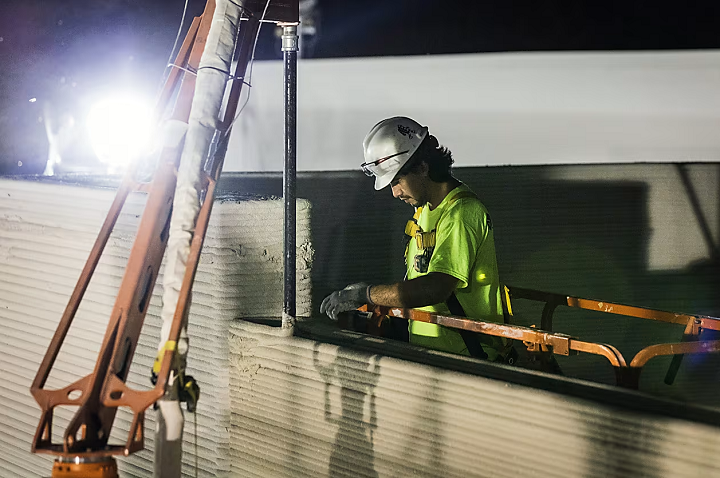
One worker is always positioned to closely observe the robot arm’s output and to make sure the concrete is holding firm.
The project was delayed several weeks due to the aforementioned material issues, as well as trouble getting local building permits. But as time went on, things became easier and more efficient. Alquist worked with FMGI, a full-service general contractor that has completed many past construction projects for Walmart. Darin Ross, FMGI’s CEO, said this Walmart expansion project was a blend of his company’s “traditional construction guys” and Alquist’s “new technology guys and gals.” By combining the digital technology of 3D printing with the more traditional subtractive methods of construction, the team successfully completed the Walmart expansion.
That’s something Stephan Mansour, a consultant at Wohlers Associates who specializes in AC, touched on earlier this year at the biannual ASTM F42/ISO TC 261 meeting. 3D printing is “not this revolutionary type of tool that’s going to make magic,” but rather just another useful tool in the toolbox. Perhaps someday soon, it won’t be out of the ordinary to see robotic AC systems on construction sites next to excavators and cranes.

The Walmart job finished weeks behind schedule after construction crews contended with finicky material and clogged hoses.
There haven’t been too many CRE projects completed with 3D printing, because contrary to what’s been reported, the technology is not always faster or less expensive than traditional construction. The Walmart project didn’t finish on schedule, and it was reported that the cost of 3D printing the expansion for the Tennessee store was about the same as it would’ve been using typical methods. But, Walmart was apparently satisfied, as it’s already hired Alquist for another similar construction project. Walmart had $611.3 billion in revenue last year, so a lot is riding on the company taking the lessons it’s learned and applying them.
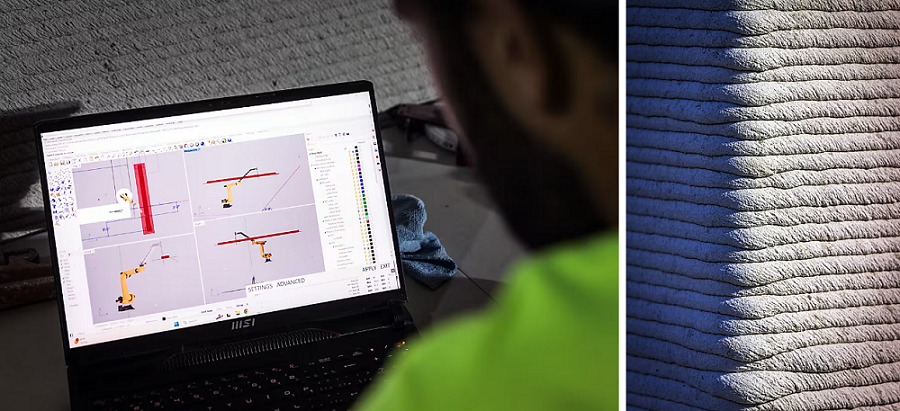
The construction site in Tennessee blended ‘traditional construction guys’ with tablet-toting, ‘new technology guys and gals.’
Images: Dustin Chambers for WSJ
Subscribe to Our Email Newsletter
Stay up-to-date on all the latest news from the 3D printing industry and receive information and offers from third party vendors.
Print Services
Upload your 3D Models and get them printed quickly and efficiently.
You May Also Like
Nikon SLM Solutions Partners with ATI and Bechtel Plant Machinery on 3D Printed Hypersonics
One of the world’s most demanding technical challenges is the creation of maneuverable hypersonic vehicles. The country that does so well will command the ultimate high ground. They will essentially...
3D Printing Financials: Velo3D Looks to Bounce Back with Defense Deals
Velo3D (OTCQX: VLDX) is working hard to get back on track. The metal 3D printing company brought in $9.3 million in revenue during the first quarter of 2025, slightly below...
3D Printing Financials: Stratasys Kicks Off 2025 with Fresh Cash and a Tight Grip on Strategy
Stratasys (Nasdaq: SSYS) started the year with strong momentum, adding fresh cash to its balance sheet and achieving profitability on an adjusted basis. The company also gained a new investor,...
Chaos & Opportunity
Great fortunes are lost and won amidst quicksand. When well-trodden paths turn to labyrinths, the concrete is sublimated into morass, sunshine turns to hail, and 20/20 vision becomes blindness; new...



